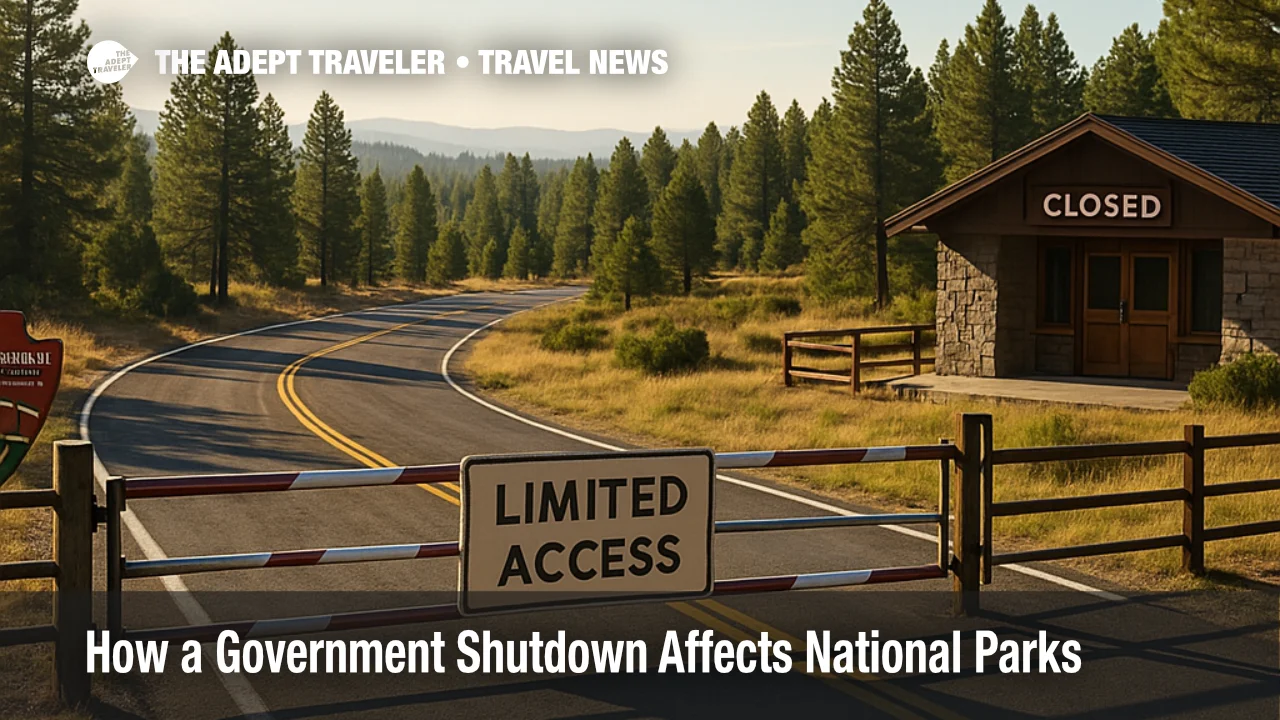How a government shutdown affects national parks

National parks generally remain accessible during a federal government shutdown, but services drop to the bare minimum. The National Park Service (NPS) shifts to limited staffing focused on protecting life, property, and public health, while many visitor services pause. Depending on each park's fee balances and accessibility, restrooms and trash pickup might continue in some places, while others close gates and buildings entirely. Expect no new permits, curtailed campground operations, shuttered visitor centers, and area closures when safety or resource damage becomes a risk.
Key Points
- Why it matters: Access may continue, but services, safety coverage, and information are sharply reduced.
- Travel impact: Restrooms, trash pickup, and visitor centers often close; some campgrounds and roads may shut.
- What's next: Parks can further restrict access if sanitation, weather, or resource damage becomes a concern.
- Concessions may operate only where they do not need non-excepted NPS support.
- No new special-use or backcountry permits are issued during the lapse.
- Park websites and social media halt routine updates; emergency posts only.
Snapshot
Under the NPS contingency plan, park roads, trails, and open-air memorials generally remain accessible. Sites with Federal Lands Recreation Enhancement Act (FLREA) fee balances can fund limited basics like restrooms, trash removal, law enforcement, and emergency response. Parks without accessible areas, or those facing safety or resource-protection issues, will close facilities and restrict access. Buildings locked after hours remain locked throughout the lapse, and no new permits are issued. Park websites and social channels pause routine updates, so travelers should not expect current road or trail conditions. If sanitation lapses, weather hazards, or resource damage emerge, superintendents can close areas quickly until risks subside.
Background
Shutdown operating rules come from OMB's lapse guidance and bureau contingency plans. NPS identifies "excepted" functions to protect life and property, plus limited "exempted" activities funded by non-lapsed sources such as FLREA fee revenue. During a lapse, overall NPS workforce is significantly reduced, with only essential staff on duty and many employees furloughed. The 2018-2019 shutdown illustrated risks from operating with minimal services, including sanitation problems and resource damage at high-traffic sites. Current policy allows donations from states, tribes, and partners to sustain certain services, but NPS will not reimburse those contributions. Concessioners may operate only if they require no non-excepted NPS support beyond critical health, safety, or protection services. If conditions deteriorate, superintendents can close areas, limit access, or halt concession operations to keep people and resources safe.
Latest Developments
What stays open, what shuts, and where concessions fit
Most outdoor areas that are normally open without a key or ticket remain accessible, but services vary by park and can change quickly. Sites with sufficient FLREA balances may maintain restrooms, limited trash pickup, entrance staffing for safety messaging, basic road care, emergency operations, and some campground functions. Buildings, gated lots, and visitor centers typically remain locked. No new special-use or backcountry permits are issued; volunteer programs pause if NPS oversight is not available. Concessions and partner-run services can continue only when they do not need additional NPS staffing beyond excepted roles. Parks may accept donations to fund specific services, but they will not reimburse donors. If sanitation, weather, or resource-protection thresholds are crossed, superintendents will close affected areas until conditions are safe.
Government shutdown: What it means for air travel
Analysis
For travelers, the operational gray area is the real pain point. "Open" does not guarantee functioning restrooms, trash service, campgrounds, or timely emergency response, and the level of basic services hinges on each park's fee balances and priorities. With websites and social media frozen for routine updates, on-the-ground conditions can lag public expectations. This creates planning friction for day hikers and road trippers, but it especially complicates backcountry travel, climbing, paddling, and winter access where permits, ranger briefings, and current condition reports normally reduce risk.
Concession operations are not a universal workaround. Outfitters, lodges, and tours can run only when they do not require additional NPS support. If operations would pull limited staff away from health, safety, or protection duties, superintendents must scale back or suspend those activities. Meanwhile, gateway communities feel a double hit: lower visitor spending when services are constrained, and higher local costs when sanitation or traffic spills over onto town infrastructure.
The most resilient trip plans during a lapse are simple and flexible. Choose low-risk itineraries near populated areas, confirm private or state-managed alternatives when possible, and prepare for self-reliance: carry extra water, waste bags, a paper map, and a first-aid kit. If you arrive to locked gates, move on rather than attempting alternate access; closures are often tied to staffing or resource-protection limits you cannot see from the road. Above all, minimize impact by packing out everything, including hygiene waste, to help protect the places you came to enjoy.
Final Thoughts
Plan for access, expect fewer services, and be ready to pivot. A shutdown can leave parks technically open but functionally constrained, with locked buildings, scarce restrooms, no permits, and limited rangers. Keep plans lightweight, carry what you need to be self-sufficient, and leave no trace. If conditions look unsafe or unsanitary, skip that trailhead and choose a lower-impact alternative. Gateway towns and small businesses are part of the park experience, so treat them kindly during service gaps. With flexible timing and realistic expectations, you can still have a rewarding trip during a government lapse at national parks, even amid a government shutdown national parks.
Sources
- National Park Service contingency plan, U.S. Department of the Interior
- Operations in the absence of appropriations, U.S. Department of the Interior
- National Park Service: Government shutdown issues, Congressional Research Service via Congress.gov
- National parks will remain mostly open in shutdown, Politico
- National parks will remain "generally" open during the shutdown, Associated Press
